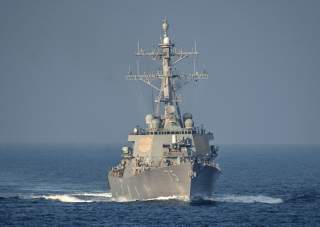The Great American 'Return' to the South China Sea?
The withdrawal of American power from the South China Sea created a vacuum—one which China now feels powerful enough to fill. However, a solution might be coming.
President Obama will land in Manila this week at a crucial time in the Philippines’ quest for security in the South China Sea. Following on the heels of U.S. freedom of navigation operations in the Spratly islands, the Permanent Court of Arbitration ruled that it had jurisdiction in a case brought by Manila against Beijing regarding the latter’s South China Sea claims and, a few days later, word leaked that the Philippine Supreme Court was set to uphold as constitutional the US-Philippines Enhanced Defense Cooperation Agreement.
The PCA case and the EDCA represent parallel tracks in Manila’s efforts to halt China’s creeping expansion in the South China Sea. Both tracks are likewise crucial to the United States’ own Asia strategy.
The Supreme Court has unfortunately delayed issuing a ruling on the EDCA. If it ultimately rules in favor as expected, the EDCA will provide U.S. forces with access to a number of to-be-determined bases in the Philippines—likely including Clark air base, Subic bay, and facilities on Palawan island, close to the disputed Spratlys—and allows units operating from them to engage in a wide variety of military activities, from joint training to disaster relief to the nebulous “other activities as may be agreed upon by the Parties.”
When the EDCA goes into force, it will mark a belated rectification of a mistake dating to the early 1990s, when the United States closed its bases in the Philippines at Manila’s request. As is now plain to see, the departure from Subic and Clark had strategic consequences with which the United States is still grappling. A period of heightened tension in the South China Sea followed, with more frequent dangerous incidents occurring as claimants to disputed territories acted more aggressively.
Perhaps the most well known incident involved China’s secret occupation of and construction on Mischief Reef in the Spratlys, discovered accidentally in January 1995. Fast-forward twenty years and China has now engaged in extensive dredging at the reef and is building facilities, apparently including a runway, it may use to project power deep into maritime Southeast Asia, to threaten commercial and military passage through the South China Sea, and perhaps to impose an air defense identification zone over the sea.
The withdrawal of resident American power from the South China Sea created a vacuum—one which China now feels powerful enough to fill, much to its neighbors and America’s dismay.
With the EDCA, the United States will once again become a resident power in the South China Sea, and any concerns in the Philippines over American commitment to the alliance will be eased. But American military might will not alone bring stability to the region. Indeed, the United States is counting on its allies and partners to partake in efforts to constrain Chinese assertiveness.
The Philippines is crucial among them. Importantly, the EDCA will facilitate accelerated military modernization of Manila’s armed forces. But just as important, the Philippines’ weakness relative to China and its pursuit of international arbitration to defend its interests—especially when compared to China’s refusal to engage in such arbitration when it is treaty-bound to do so—has given it the moral high ground. Manila is an underdog, employing peaceful means in defense of what it believes to be right. That narrative isolates China as something apart from the international community of peace-loving, law-abiding nations, an outcome that can, along with allied military strength, positively shape Chinese behavior.
Unfortunately, whether Manila continues to show such backbone in the months and years ahead is an open question. President Obama will arrive in the Philippines just under six months before the country’s next presidential election. Benigno Aquino, a president unfazed by Chinese threats, is not eligible for a second term. And while it’s far too soon to venture a guess as to who will win the presidency, at least some of the leading candidates have voiced more conciliatory—though certainly not appeasing—approaches to Beijing.
Mar Roxas, whom Aquino has endorsed, appears most likely to follow the present course. Like all of the candidates, Jejomar Binay, Aquino’s vice president, has promised to defend Philippine claims. But certain of his comments—for example, “China has money, we need capital”—and the invoking of “deep filial ties” between China and the Philippines, have raised eyebrows in Washington.
Meanwhile, senator and presidential candidate Grace Poe, while supportive of Aquino’s approach to China, has argued that “we cannot fault [the Chinese] for thinking of their own interests” and that even as the Philippines should continue the arbitration case, the country must remember that “our relationship with China dates back centuries.” She recently voted in favor of a resolution conveying the Senate’s view that the EDCA will be invalid without the legislative body’s approval, regardless of the Supreme Court’s finding.
When President Obama is in Manila, he should remind the Philippines that true prosperity—which China implicitly holds up as the prize for succumbing to its will—is not possible without genuine freedom, a just order, and a peaceful environment. He should make clear American commitment to defending those principles and he should call on the Philippines to do its part in building an Asia that is prosperous, peaceful, and free. It’s a message that the Philippines’ presidential hopefuls should take to heart.
Michael Mazza is a research fellow in foreign and defense policy studies at the American Enterprise Institute (AEI). You can follow him on Twitter: @Mike_Mazza.
Image: Flickr/U.S. Navy

